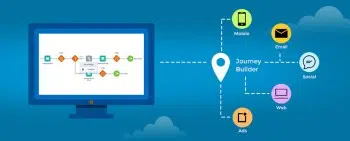Salesforce Journey Builder is a powerful tool, but it requires good data to deliver the maximum ROI. Most anonymous web traffic bounces, and that means you’re missing out on all that data—unless you do something about it. The best way to make sure you’re collecting as much data as possible is website visitor identification.
This article will cover what Salesforce Journey Builder is, what website visitor identification software does, and how the two tools work together to increase revenue.
What is Salesforce Journey Builder?
Salesforce Journey Builder is a customer lifecycle management tool provided as a part of the Salesforce Marketing Cloud. It enables you to target customers with personalized campaigns based on their progress through the customer journey.
With Journey Builder, you can reach customers at every touchpoint with consistent messaging that’s relevant to their immediate needs. For example, someone who is browsing an eCommerce website will need different information than someone who is trying to check out.
Journey Builder pulls all your data into one place so you can use it to trigger messaging based on real-time events (e.g., purchases or downloads). Then, you can measure the performance of your campaigns to see what’s working and identify bottlenecks.
What is Website Visitor Identification?
Website visitor identification technology uses sophisticated tracking and third-party data to match up to 40 percent of your anonymous web traffic back to records with your visitors’ names, email addresses, mailing addresses, and more—even if they don’t convert on your website.
That means that when you send paid traffic to a landing page, you’ll be able to reach out to people who don’t convert directly through email, direct mail, and other campaigns. That way, you can continue to build a relationship with them through highly personalized campaigns instead of relying on remarketing ads.
LeadPost’s visitor identification platform offers a one-click integration with Salesforce, so that data can be pulled directly into Journey Builder. This data facilitates greater personalization, more effective customer lifecycle management, and increased sales.
How Does Website Visitor Identification Enhance Salesforce Journey Builder?
Depending on your product or service and the industry you serve, there are many attributes that should guide your messaging for different customer segments. The more data you have, the more granular your audience segments can be.
Journey Builder can aggregate data from a number of sources, like LeadPost, so that you better understand your customers and have more visibility into what campaigns work best for different groups.
Here are a few of the customer details you can import into Journey Builder with visitor identification:
- email address
- mailing address
- phone number
- automotive data
- household income range
- age range
- education level
- gender
- homeowner status
- length of residence range
- net worth ranges
- marital status
- presence of children
Not only will these details enrich your current contact records, but they will also enable you to reach out to contacts who wouldn’t be in your database otherwise.
Enhance Journey Builder with Website Visitor Identification Data
Website visitor identification is the best way to scale your Journey Builder campaigns. Right now, you can get 100 free leads from LeadPost to see if the platform is right for you. Then, you’ll be able to maximize Journey Builder’s potential.
